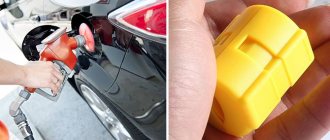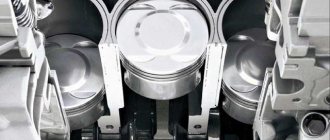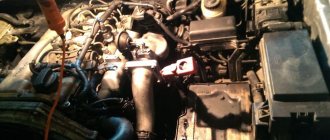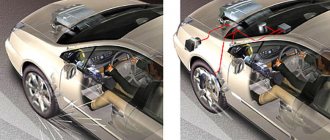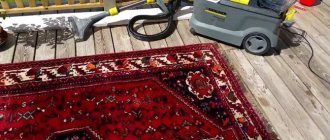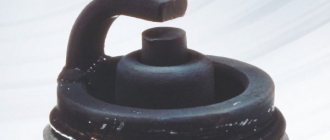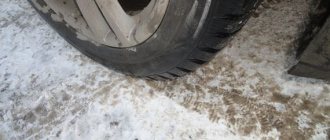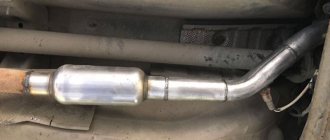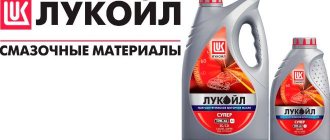The glossy rich factory coating fades over time, becomes covered with scratches, and constantly gets dirty. The solution to prevent aging of paintwork is automotive liquid glass (LC). A special product that is applied to the top of the car's varnish. Treating your car with liquid glass will be the best option, and the price of such protection is affordable.
Where and for what purpose the product is applied, where, in what areas it is used and applied. Why is it necessary at all, for what purpose is liquid glass intended? We’ll talk about this in the article, read it to the end. The composition, properties and its characteristics have expanded the method and scope of application from construction to the automotive sector. To put it simply, this product will give the body a “mirror” effect. The use of ZhS will protect against minor damage and will repel dust, moisture, and dirt due to its hydrophobicity. It is only important to follow the application technology (especially at the stage of cleaning the body).
What is automotive liquid protective glass?
Now let's talk about liquid glass, what is it, where and when can it be used? ZhS is also called ceramic varnish or silicate glue. Soluble ZhS is a car body polish that both restores the paintwork and gives it a “mirror reflection” effect if applied correctly. Also, liquid glass fills small unevenness and roughness, scratches, this will make the result before and after very noticeable. In addition, some types of it can be used to coat optics. The product can be used once every six months, a year, depending on the number of washes.
You can cover your car with liquid glass yourself if you are confused by the price of the service.
The operating principle is simple:
- The substance is applied to the surface of the car.
- It penetrates the structure of the original coating, adhering to its molecules.
- A strong, smooth film is formed, through which neither dirt nor water can seep through. You can save money on car washing.
Essentially, JS is something between decorative cosmetics and a protective product. Moreover, it lasts longer than many other analogues - the car only needs to be polished once every 1-3 years, and not monthly.
What is included in liquid glass?
To understand what is included in liquid glass, you need to turn to the market and see what it offers, what ingredients manufacturers put into this product.
Let's take one of the Wilson Glass Guard polishes, which, as the manufacturer assures, is capable of protecting the car body for 1 year.
The basis of the product is silicon organic composition - silicon dioxide, as a rule, this is 10-20% of the total volume. When it is applied to the body, a passive film is created on the paintwork.
In other words, passivation occurs, as a result of which the surface of the machine is effectively protected from external influences.
As a result of passivation, polymerization occurs - the smallest glass crystals lie evenly on the body in several layers and penetrate the paintwork at the molecular level. The thickness of one layer is several microns.
In fact, silicon dioxide is quartz that can only be dissolved by hydrofluoric acid, which is absent in the environment.
Other, additional ingredients are a trade secret; they may differ for each manufacturer.
In fact, this type of polish should have been called “Silicon Dioxide”, but marketers came up with another, more sonorous name for it – “Liquid Glass” so that the product would be sold better.
Types of liquid glass, their differences in quality and price
There are 3 main types:
- Liquid sodium glass has a loose structure, what is it for, you ask? This liquid glass repels water well, is not afraid of atmospheric influences and temperature changes, its price is affordable, and it is used to cover cars. Improves the view. The use of this liquid crystal gives the same “mirror” effect on the surface of the material.
- Liquid potassium glass. The properties are the same as in sodium liquid iron, only the fire resistance is higher. In addition, potassium does not give a “mirror” effect, unlike the first option. But the coating is stronger, which serves as protection.
- Lithium. Rarely found on sale. This type of liquid crystal is used as a thermostat for the surface of a car. This liquid glass was created as a thermostat for spacecraft. That is, as a substance that maintains the temperature of a material, for example, metal, at a certain level.
Which liquid glass is better to choose for a car, sodium or potassium, is decided by the owner of the car, based on his preferences. LS for cars are divided into semi- and professional. What is the difference:
- Semi-professional ones are cheaper and easy to apply yourself.
- Professional ones are more expensive and more difficult to work with. Such polishes require special skills, equipment, and conditions. It is necessary to maintain a strictly defined temperature, observe the speed and number of layers being applied, and temper the substance with an IR lamp. If you make mistakes, the car owner risks damaging the body.
The color of the paintwork is different for each car, so polish manufacturers produce 3 product options: with a light shade, with a dark shade and universal (suitable for any body).
Japanese glass Willson Body Glass Guard
Protective polishing of a car is achieved using liquid glass material. The most famous liquid glass for cars in Russia and the CIS countries is Willson Body Glass Guard. It has its pros and cons. Cost - from 3000 rubles. Supplied in the form of 2 components (bottles): the polish itself and the activator. They are mixed in equal proportions (1:1), then applied to a clean, grease-free coating. The thickness of 1 protective layer is 0.8 microns. The declared service life is a year, although some car owners noted that it is necessary to “glaze” again after 6-8 months. The coating will have to be renewed even after 40-50 contactless washes. The line is divided into 2 subtypes: for cars of light and dark shades. Wilson is easy to apply in 2-3 layers, you just need to wait 45-60 minutes. The original Body Glass Guard is sold in 3 versions, each volume has its own cost:
70 ml; 110 ml; 140 ml.
Car enthusiasts praise this JS because it has a significant number of advantages:
- The car is easier to wash.
- The “web” disappears from the body.
- The color of the paintwork becomes more saturated.
- Can be applied without special skills or tools.
- Affordable price.
There are also dissatisfaction:
- The drying time of liquid glass depends on the layers, and since in this option there is only one layer, it is 12 hours, from 2-4 layers it is 24 hours.
- May last less than stated by the manufacturer.
- The market is full of low-quality Willson fakes, although the original can be distinguished by price, box, name, and equipment.
Best One-Piece Japanese Glass Willson Silan Guard
Silane guard or protective liquid glass silane guard for cars is distinguished by a reinforced silicone film, which more reliably protects against minor scratches. The manufacturer promises that it will protect the car from salt reagents in winter and highly alkaline shampoos in contactless car washes, and will provide heat resistance. It is also known how long liquid glass lasts on a car body: its service life is approximately 1 year.
This Japanese liquid mixture has a one-component composition (no need to mix anything). It will fit and look great on a white car, or any color in general, including pearlescent or metallic. The largest bottle (95 ml) should be enough even for a jeep or minibus. Applying 2-3 layers is already more difficult than with Body Glass Guard. After all, after polishing the first one, the second one collects in droplets and does not set well. Masters first apply 1 layer, let it dry and, without smearing, add more on top. Only then do they polish it. Experience and skill are important here so as not to overexpose the substance.
In addition, Willson directly recommend not to use this Wilson Silane Guard liquid protective glass for plastic, on bumpers, and optics. The manufacturer also does not recommend covering rubber and chrome-plated parts with silane guard. What should not be neglected for a car whose price is high. If the substance gets into the wrong place, immediately wipe it with a damp cloth; it is very difficult to dissolve it later. The original Willson Silan Guard is sold in 2 versions:
- 57 ml;
- 95 ml.
Is it worth taking?
In addition to the practical benefits for the body, the latter also receives a lot of attractiveness. After treating a car with liquid glass, it looks perfect and flawless, as if it had just rolled off the conveyor belt. If you put two cars side by side, where one is covered with a polish of this kind, then the difference is not only noticeable, but it hurts the eye.
You should also notice significant benefits when washing your car manually. If previously washing required shampoo, a lot of water and a whole bunch of rags to make it shine, now you just need to rinse the body with a small amount of liquid, and your faithful friend will shine again. Even a little rain is enough to get your car in order.
The owner of a car polished with liquid glass is not at all afraid of stains, dirt or minor scratches. Yes, such cosmetics have a far from affordable price tag, but they are worth the money, and the result, after treating the body, will be stunning.
How to Apply Willson Body Glass Guard Yourself
All modern housing systems are used according to the same principle. Polishing is divided into 2 stages:
- Body preparation (washing, degreasing, drying). This is the hardest part.
- Applying polish. Even a beginner can handle it.
First of all, we buy ZhS. You need to choose only semi-professional products, since they do not require special skills and equipment. In addition, you need to choose the shade of the polish (universal, light or dark), based on the color of the car’s paintwork. We select the volume (ml.) according to the size of the car: sedan - 70, crossover (SUV) - 110, large SUV - 140. Along with the vehicle, the package should contain:
- Rubber glove. Protects the skin of the palm from alkali.
- Applicator (sponge) with polypropylene cloth. Needed for applying ZhS.
- Microfiber cloth. Useful for polishing the substance.
If something from the list is missing, you need to purchase it separately.
To pre-treat the body you will need:
- car shampoo;
- microfiber mitten or large-pored sponge;
- synthetic clay;
- body cleaner;
- degreaser;
- dry rags;
- microfiber cloth (not the one included with the ZhS).
You can “glaze” the car only in a dry (humidity up to 50%), warm (temperature not lower than 15°C), clean and ventilated room. It should be spacious so that it is convenient for a person to approach the car from any side, well lit so that they can see every area on the body. A simple garage will do, but not the street - wind, precipitation, dust, sunlight, low temperatures will ruin the work.
Clean and degrease the body
If there are deep scratches or chips on the paintwork, restorative polishing of the paintwork is needed. This is especially true for vehicles with a mileage of 10,000 kilometers or more. You can clean and degrease the body even on the street, but only in the shade. Otherwise, the chemicals will dry out in the open sun, leaving stains on the body.
The first step is hand washing:
- We wet the surface of the car.
- Add shampoo to a bucket of clean water and mix.
- We wet a mitten or sponge in this bucket and wipe the body.
- The thresholds, wheels, bumpers and the lower part of the arches are washed last. They can pick up dirt that will scratch the body.
- Rinse the shampoo off the car.
Second step - deep cleaning
If you run your hand over a washed car, the body will seem rough. These are mechanical inclusions that need to be removed:
- We wash the surface of the car.
- Take synthetic clay and knead it into a flat cake the size of your palm.
- We clean the entire body as if with a rag. A layer of dirt will remain on the clay.
- After deep cleaning, move your hand over the car. If the surface is perfectly smooth and the palm does not feel any roughness, then everything is done correctly. Otherwise, you need to go through the clay again.
The third step is treatment with a special body cleaner to remove stubborn stains.
Apply the substance to a sponge and rub the surface of the car. This can be done using a polishing machine. Then remove any remaining cleaner using a microfiber cloth. When you rub your finger on the surface of the car, you should hear a characteristic squeak. The fourth step is degreasing. We apply anti-silicone or a similar product to the body. Wipe with a dry cloth or polypropylene cloth. We wait until the degreaser evaporates. Remember that the quality of adhesion of the liquid coating to the paint coating depends on the preparatory stage. Working with liquid glass requires care and precision. If even the smallest specks remain on the body, the adhesion of the polish will deteriorate and its service life will be shortened.
Applying “glass”
How to use liquid glass correctly and how to apply liquid glass to a car? We place the dried and prepared car in the desired room. We unpack the liquid crystal, put on a rubber glove, and open the bottle of polish. Two-component liquid glass must be prepared according to the instructions. The price of the entire paintwork is at stake. If you use Willson products, then tear off the label from the bottle cap, which will leave characteristic marks. This is a sign of an original product, not a fake. Please note that the shelf life of Body Glass Guard liquid glass is 6 hours after opening. Silane Guard can be used for 7 days.
How to apply liquid glass to a car:
- Shake the composition so that there is no sediment.
- Cover the applicator with a polypropylene cloth and wet it. The sponge should be completely soaked.
- Using smooth, light movements, apply the substance to the car - an oily layer will appear. You can cover any glossy surface (body, optics, bumpers, wheels). There is no need to rub or make any effort.
- We wait 10-15 minutes for the applied layer to become matte.
- We take a rag from the kit with ZhS. If there is a paper label hanging on its edge, tear it off so as not to scratch the body.
- We smear the substance with this rag until the layer becomes glossy (mirror-like). No need to rub or press.
Instead of the supplied napkin, you can use a polishing machine - it will be easier and faster. The circle needs a finishing or soft foam rubber for an anti-hologram coating.
After 45-60 minutes, you can apply a second layer of liquid glass on top of the first layer to enhance the protection and mirror effect on the body. The difference between third, fourth, etc. will no longer be so noticeable. The question may arise as to how long it takes for liquid glass to harden and dry. When the job is done, we leave the car indoors for 12-24 hours so that the liquid mixture is completely dry. If you hurry, leaving ahead of schedule, then every speck of dust you come across will stick to the coating. It is better to wash a “glazed” car with a damp microfiber cloth. The use of auto chemicals is not recommended - it reduces the service life of the coating. Contactless washing can be carried out only after 2 weeks, when the liquid crystal has completely polymerized. Depending on the manufacturer of the polish and the quality of the body pre-treatment, re-glazing will be required after 0.5-1.5 years.
How much will it cost to cover a car with liquid glass?
Liquid glass for a car is a type of polish that is applied to the vehicle body, giving it an attractive appearance and protecting it from adverse environmental factors. This kind of coating is used quite often for a car, as it allows you to return it to the appearance “as at the time of purchase” at low cost. In addition to the mentioned visual effect, the substance has the following advantages:
- protects the body from dirt, dust and ultraviolet radiation;
- repels water masses;
- not afraid of road reagents;
- gives the body a uniform mirror shine;
- easy to apply.
However, such a polish also has some disadvantages, namely:
- requires careful preparation of the body for application;
- is not cheap;
- demanding when washing the car afterwards.
Liquid glass is based on a compound of sodium and silicon, which, after application to the body, forms a thin coating, the structure of which is reminiscent of and partly represents glass. This is where the name of the product comes from.
Important! Due to its unique structure, liquid glass polish requires careful handling after application to the car body. The fact is that using abrasive shampoos to wash a car coated with liquid glass, or contact washing with brushes at a car wash can reduce its service life by 2 or even 3 times.
We suggest you familiarize yourself with How to make a greenhouse with your own hands
If you want to coat your vehicle with “liquid glass” polish yourself, you first need to prepare the following tools:
- liquid glass directly;
- car shampoo;
- degreaser;
- sponge;
- microfiber cloth.
After preparing the necessary means, you can begin the procedure of applying polish to the body, which goes like this:
- First of all, choose a place to upgrade your car. It is important that the place where liquid glass will be applied to the car body is free of high humidity, cold, dusty and sunny. Otherwise, the application of polish may be overshadowed by an unpleasant consequence - deterioration in the appearance of the car.
- Then wash the car thoroughly, clearing all areas of the body of dust, dirt and stains.
- After washing, let the car dry and apply a degreaser to its surface (for example, the well-known white spirit diluted with water).
- Using the instructions for liquid glass, bring it into a form in which the product is ready for use. Some polishes require shaking and opening, while others must first be prepared by mixing liquids in certain proportions. Specifically in your case, act exclusively according to the instructions for liquid glass, and nothing else.
- Now that the previous steps have been completed, all that remains is to apply the polish. To do this, apply a small amount of polish to the fiber and begin to rub the product in a thin layer over the body in a circular motion. The best effect can be achieved if you “polish” individual parts of the body step by step: first the bumper, then the hood, then the roof, and so on. Otherwise, the substance may harden earlier in some areas of the body, which will cause uneven application.
Important! If previously, before liquid glass, a different polish was applied to the car, it must be wiped off with special pastes, since applying one product to another will not give the desired effect.
It is worth noting that preliminary drying of liquid glass occurs within 3-6 hours after its application to the body, and final drying occurs after 14 days. After the first period, the car can be used, and at the end of the second, it can be washed, but in compliance with the previously stated rules. As a rule, liquid glass can withstand about 15-30 properly organized washes.
In general, applying liquid glass to your car is not so difficult. The main thing is to know the features of this procedure, which are discussed in detail above. We hope today's material was useful to you. Good luck on the roads!
Video on how to polish a body with liquid glass:
- reliable protection of the body from any external influences (including chemical);
- guarantee of high-quality and rich “native” car color and “mirror” effect;
- affordable price when compared with the duration of the effect that the polish gives;
- effective elimination of small cracks and scratches that often remain after washing a vehicle;
- durability. As a rule, even with year-round use, liquid glass is retained on the body for 9-12 months;
- the ability to quickly adjust color in case of surface tarnishing;
- effective repulsion of dirt and water from the surface;
- UV protection. As a result, the paintwork is reliably protected from sunlight;
- heat resistance. You can be sure that even with strong heating, the quality of the coating will remain at a high level;
- antistatic effect. This option is especially useful in winter, when a static charge accumulates on the surface of the car;
- hardness of the material. During the production process, special elements are used that ensure maximum hardness of the material. At the same time, liquid glass in its performance becomes very similar to glass;
- absolute transparency. This quality ensures maximum body shine and color depth.
- Check the polish package. The composition should contain the following tools: hardener and base composition, pipette (necessary for mixing), special fiber for manual polishing, protective gloves, towels and a soft sponge. If the kit is missing something, it is better to buy more.
- Now prepare the surface of the vehicle. This stage is one of the most important in the polishing process and should not be skipped. Wash the car and remove any existing dirt. After this, degrease the surface and let the car dry. Degreasing can be done using white spirit diluted in water. Under no circumstances should you use a composition containing silicone or low-quality alcohols. If the car body has already been covered with any of the polishes, then it must be completely removed. Otherwise, the new coating layer will not adhere well to the body and will last much less than the intended period.
- Select a work site. The best option is a dry, well-ventilated place, the temperature in which is from 10 to 40 degrees Celsius. It is best to carry out polishing in the garage, but in extreme cases you can do it outside under a special canopy. Your task is to prevent accidental exposure of the body to sunlight, dust and dirt.
- Completing of the work. Once the preparatory work is completed, you can begin polishing the vehicle using liquid glass. You should not apply the composition to the entire body at once - practice on a small area of the car. If the polish adheres well to the surface and provides the expected result, you can begin to work.
Please note that liquid glass must be applied to the car body gradually, treating area by area. For example, you can start with the right fender or bumper polish. Once the processing of one part is completed, you can move on to the next stage. This approach is necessary for two reasons.
After applying a small amount of the composition to the surface, rub it with a soft cloth (should be included in the kit). While performing work, make sure that no dirt or dust gets on the body at all times. Once the entire body has been processed, leave the car alone for several hours (usually 4-6 is enough).
We suggest you read How to make tofu cheese at home
In this case, the final setting of liquid glass occurs after two weeks. During this period, it is advisable not to wash the car at all (especially at a car wash). After a two-week period, the car body is reliably protected from various mechanical influences: UV rays, moisture and other unpleasant manifestations.
How to speed up the process? Typically, polishing a car by hand takes at least 5-6 hours (if done well). This work is very difficult and many may not be able to withstand such a load. To make the task easier, you can use a sander. All that is required is to select a soft polishing pad and set the speed to medium. During processing, try not to press on the sander to prevent overheating of the surface.
If you don’t have a sander at hand, then a regular electric drill is a suitable alternative. In this case, it is worth purchasing an attachment for fixing polishing wheels in advance.
That's all. Now you can enjoy the perfect appearance of your car's body and periodically update the coating. According to the manufacturers, liquid glass remains on the surface for up to one year and can withstand up to fifty visits to a car wash. In addition, to put your car in order, all you need is a bottle of water and a clean rag.
You can purchase the product in specialized stores. The kit includes:
- hardener and base agent;
- mixing tube;
- cloth for rubbing;
- gloves;
- various towels and sponges.
There is also an instruction manual with a detailed description of the polishing process in Russian.
Before you start work, make sure the surface of the car is clean. It must be clean, grease-free and dry. It is better to wash your car with special shampoos with a degreasing effect. Old polishing must be removed with special means.
Chevrolet announced the cost of the 2020 Traverse model year
Dacia Duster 2020: debut in Paris
Citroen C5 Aircross 2020: restyling details
The optimal temperature for polishing is from 10 to 40 degrees; in winter, processing in a heated garage is allowed. In summer, the surface of the body should not be hot; direct sunlight should be avoided during operation. The process takes 3-4 hours and is quite feasible for anyone if you follow the recommendations in the instructions.
When polishing your car yourself with this product, follow all stages of the work:
- You should start work in a clean room, where moisture, sunlight and dust do not penetrate. If it is a garage, you should wash it well.
- Read the instructions carefully.
- Try the product on a small area. To do this, moisten a sponge with the product and rub the surface. After one or two minutes, wipe the surface again with a damp cloth.
- Each body part is processed separately; in large areas, you simply may not have time to thoroughly rub the surface. The product hardens very quickly and will be really difficult to remove.
- Leave to dry for at least 6 hours; for another week, it is prohibited to use chemicals for car washing. Different polishes are sold for light and dark cars; this feature should be taken into account.
What is ceramics
This is another means of protecting a car's paintwork. What is the difference between ceramics and liquid glass? The chemical composition is almost the same. But the difference is in the structure of SiO2: in ceramics it is ordered, in contrast to the chaotic one in liquid glass. The first option is stronger.
If you choose: liquid glass or ceramics for cars, which is more reliable and better, there is something to pay attention to. Due to its crystalline structure, the second has 2 advantages over GS:
- More reliably protects the paintwork from external irritants.
- Longer service life.
The ceramic hardness index according to the Koh-i-Noor scale is 9H (this is the maximum). A body covered with such material becomes stronger and more easily withstands mechanical stress. It won’t save you from a direct blow, but it will protect you from branches, pebbles, etc. - guaranteed. Even in harsh climates, ceramics will protect the car for 2-3 years of active use.
There is also a difference between liquid glass and ceramics in price. The only drawback of this coating is that it is expensive. Therefore, ceramics are applied only by wealthy car owners. Liquid glass is cheaper and more accessible to the mass consumer. But at the same time, it is not as durable as ceramics and wears out faster, which is the difference.
When deciding on car protection, the question may arise: nanoceramics or liquid glass. In any case, it is up to the owner of the car to decide what is best. Liquid glass or nanoceramics are more suitable. Sometimes it’s better to apply it more often than to throw away a lot of money and repeat the procedure after 2 years
What is liquid glass for a car?
Liquid glass for a car is a substance that contains silicon dioxide and silicate compounds. In fact, such a polish is popularly called liquid glass because of the visual effect it causes. A body coated with liquid glass has a rich paint color, the shine of freshly applied varnish and a reflective effect similar to a mirror. The polish is applied not only to the body, but also to the glass with headlights. The coating also serves as a good protection for the surface from an aggressive environment, which happily strives to destroy the polish and begin to destroy the paint and varnish, and then the entire car. This is the nature of our planet; everything that is not created by it, it tries to absorb.
Advantages of body treatment with liquid glass:
- Paintwork protection (an additional layer is formed on the surface of the body, which protects the main layer of paint and varnish from mechanical damage, as well as from the effects of an aggressive environment, especially in large cities, where in winter they cover roads with various chemicals and, of course, from ultraviolet radiation);
- Restoring paint saturation (new paint effect) and color depth;
- The effect of repelling dirt and water (the dense structure of the coating does not allow water and dirt to linger, which significantly reduces the likelihood of corrosion);
- Long-lasting effect (compared to standard polishing or waxing. Liquid glass has a longer service life without loss of basic properties);
- Relatively low price (the service is not cheap, but in terms of price and service life, it is significantly superior to other means of restoring body aesthetics).
Disadvantages of liquid glass:
- Like any car care product, liquid glass has its drawbacks, otherwise it would be an ideal product for all times
- Difficulty of application (proper application of liquid glass requires a sterile room, free of dust and any insects. Ideally, a professional spray booth or car wash bay);
- Long drying time (depending on the manufacturer and method of application, drying time can last up to several days);
Formula of liquid glass in chemistry
In the manufacture of this material, silicates are used everywhere. But not, as some people believe, that liquid glass is calcium and magnesium silicates. We can say that this is a misconception; the formula of liquid glass in the science of chemistry will dispel such misconceptions. ZhS is an aqueous alkaline solution, the formula depends on the type of substance.
Chemistry represents lifesavings like this:
- Sodium – Na2O(SiO2)n;
- Potassium – K2O(SiO2)n;
- Lithium – Li2O(SiO2)n.
Liquid glass is a substance that shares only the presence of silicon dioxide (SiO2) with non-liquid glass. So silicate glue is not a brittle, breakable layer, despite the fact that silicon is used like liquid glass. In general, liquid silicates are called sodium and potassium silicates in solution. Less commonly, lithium.
From silicon dioxide, the product only received resistance to sunlight, water, and dirt. Various nano- and surface-active elements are also added to liquid crystals. There is nothing in its composition that can damage the enamel on the car body.
As a result, JS has a set of useful properties:
- Repels any liquids;
- Increases the fire resistance of the processed material;
- Protects against acids;
- Prevents corrosion;
- Prevents the proliferation of bacteria and fungi;
- Increases the density and strength of the material, filling pores and roughness on it;
- Prevents the occurrence of static electricity;
- Abrasion resistant;
- Remains on the surface of the material for a long time.
Outwardly, it is a viscous, thick, rubber-like mass that quickly hardens in the open air. ZhS is usually sold in a colorless version, but there are offers with yellow, green, and gray colors.
Contents of delivery
If you purchase a regular polish for personal application, and not for service shops, then the kit should have everything you need. No specific tools or other equipment are required to complete the work: only desire, free time and space.
Polish contents:
- branded composition in a tube;
- hardener;
- mixing bottle;
- special napkin for the body;
- gloves to protect hands from chemicals;
- several towels and a sponge;
- user manual.
Once again, it should be recalled that before applying liquid glass for a car to the body, be sure to read the manual. Moreover, it is not as comprehensive as other instructions for car cosmetics, but everything that is said there will help you not only in your work, but will also save you from a lot of mistakes that beginners in this business make. And after all, this composition costs good money, but it can be spoiled very easily.
Judging by the reviews of liquid glass for cars, most owners did not have any serious problems. Of course, there are some critical nuances in this matter, but nothing that cannot be dealt with by an ordinary car enthusiast.
Liquid glass for cars: pros and cons
This polish is used in various fields. ZhS has pros and cons specifically for car owners. Its benefits specifically for car owners:
- Bright mirror shine, like models from showrooms (only when applying sodium ZhS). The substance is transparent, so the color of the car will not be distorted.
- Correction of minor defects (shallow scratches, chips).
- Immunity to water, dust. If after rain, puddles, etc. If there are any traces left, they can be wiped off with a simple damp cloth.
- Saving time and money on car washing.
- Protection from sun rays (body color fading).
- Resistant to scratches and tangential impacts.
- Acid protection. Gasoline, motor oil, bird droppings will not leave traces.
- Immunity to paints. If the body is damaged by felt-tip pens or graffiti, then these “arts” can be easily washed off.
- Protection against the accumulation of static charges.
- Temperature resistance.
- 1-1.5 years of service in severe weather conditions (Russian).
- Headlights can be processed.
Preparing for work
Before you begin applying polish, the following conditions must be met. Firstly, the temperature outside should not be below +10⁰ and above +40⁰. Therefore, in winter it is better to do this in a garage, and in summer in a well-ventilated parking lot. Rain, snow and other bad weather can be a big hindrance, so it’s a good idea to check with your local weather service. The process itself will take from 3 to 4 hours, and if your hand is full, then even less.
If you previously covered the car with any polish, it must be removed with a special compound (purchased separately). It is better to choose the latter without silicone or low-quality alcohol, such as methyl. It should also be noted that any intermediate layer between the body paint and polish significantly impairs adhesion (adhesion of the composition to the paint).
So, the car should be:
- well washed;
- without extraneous dirt (fluff, asphalt chips, “bird's joy”, etc.);
- low fat and dry.
Then you can move on to the next steps.
It is important to be aware that life support is not a panacea for all occasions. It:
- Apply only to a clean, dry, grease-free surface. So first you need to carefully prepare the car.
- Requires a specially equipped box or at least a clean, dust-free garage.
- It crystallizes for 6-12 hours, during which the car cannot be touched. Hand washing is acceptable only after 3-4 days, and contactless washing only after 2 weeks.
- Will not protect against collisions with obstacles or large objects.
- Will not hide deep scratches. If the paintwork is badly damaged, then in good lighting the paintwork will only highlight its defects against the background of whole, shiny areas of the car.
- It will last less if you wash the car with chemicals. It is better to use only water and a soft sponge.
How much does such work cost in Moscow - to cover the entire car?
First, let’s determine how much the product for the car costs. So liquid glass, for example, Willson for cars, the price of which is ~3,000 - 7,000 rubles, is in stores in Moscow. To carry out such an application, you can, of course, order the material in the store. But in order to cover your car cheaper, namely, only the car body (without headlights and plastic), with liquid glass, you need to look on the Internet for prices lower than in Moscow. For example here
The best liquid glass for a car is not difficult to find and apply to any car. And the price of some car brands is affordable. Although in Moscow it is much higher.
Protective coating of a car with liquid glass is a good way for the owner to preserve the appearance of the car and extend the life of the paint on the car.
Let's figure out how much it will cost to cover or pour a car with such material if we cover the entire car.
Such treatment as protecting or polishing a car body with liquid glass can be done with your own hands or in a car service center by craftsmen.
The price for the procedure for a car in the service will be up to 6,500–12,000 rubles. If they use original liquid glass (although prices in the city of Moscow, in some car services can be much higher). Moreover, it depends on the material that is used. After all, the cost of liquid glass for cars varies. There are premium brands to treat your car. And the price of covering a car with liquid glass depends on this. Those who don’t mind anything for a car can choose the most expensive brands. For those who want to do everything themselves, you first need to prepare the body. Processing and polishing a car, namely a car body, with liquid glass requires preliminary cleaning; the table shows the necessary means and the price for them in Moscow.
| Means | Description | Estimated cost (RUB) | Total (RUB) |
| Weak acid or ph-neutral car shampoo | For hand washing | 1 000 | 2 800 |
| Microfiber mitten | 100 | ||
| Synthetic clay | Cleans the body of mechanical impurities, grains of sand, brake dust | 200 | |
| Body cleaner | Removes stubborn stains of resins and bitumen | 1 100 | |
| Large porous sponge | To apply the cleaner | 50 | |
| Antisilicone | Degreases the surface | 300 | |
| Microfiber cloth | For drying (removing residual water on the body) | 50 | |
| Dry rags | For rubbing degreaser | — | |
| Polishing | Will be needed for cars with deep scratches and chips; if you “glaze” the body without preliminary polishing, then the defects on it will become more noticeable | 3,000, depends on the area of damage |
And even with these costs, applying liquid glass to the car body saves money. Let’s say that during the year we wash the car weekly (50 procedures in total) and polish it once. The first service will cost approximately 50 × 500 - average price in Moscow = 25,000 rubles. Annual polishing will cost ~3,000 rubles.
After the painting is done, the body repels dirt and water. Car protection allows you to wash the car only once every 2 weeks (i.e. already 25 procedures per year). In total, 12,500 + 3,000 = 15,500 rubles will remain in your wallet; you will not have to restore the paintwork - it is protected from dust, sunlight, and other irritants.
Let's calculate, taking into account how much it costs to cover your car with liquid glass.
Net savings will be 15,500 - 8,800 / 12,800 = 6,700 / 2,700 rubles. More details so as not to get confused:
15,500 – money saved; 8,800 / 12,800 – this is approximately how much it costs to apply liquid glass to a car; Without preliminary polishing before “glazing”: 15,500 - 5,800 / 9,800 = 9,700 / 5,700. Explanation: 5,800 / 9,800 is the approximate minimum / maximum price of a LC with consumables. If you entrust everything to the masters at a car service center, we will save 15,500 - 6,500 / 12,000 = 9,000 / 3,500 rubles. It is important to consider that GS can save body parts from indirect tangential impacts. If this happens, then you can avoid repairs and save even more money.
How to apply liquid glass to a car
Coating a car with liquid glass
We recommend: When, according to the law, should you change summer tires to winter tires in 2020?
In most cases, you can apply liquid glass for cars yourself. The only difficulty of the technology lies in the correct preliminary preparation of surfaces. Choose a place to work with a normal temperature, so that the possibility of dust, sunlight and, especially, precipitation getting on the body is minimal.
First, thoroughly wash and dry the car, and if necessary, treat it with a universal degreaser. This is very important to do - the liquid glass on the car must be in perfect contact with the main surface. You need to work one by one with individual areas of about 0.5 square meters. It is most convenient to start from the roof.
The liquid must be applied to the sponge included in the kit. Then use a sponge to gently scrub the surface area. Depending on the brand chosen, after applying the product, you must wait a certain period of time (indicated in the instructions), and then perform a small polishing with a rag, also included in the kit.
After treating the entire car, you should avoid touching the body for several hours.
During the first 24 hours, you should absolutely not wash the car, and it is better to leave it in the garage altogether. Complete hardening of the layer occurs within 15-20 days, and during this period it is better not to wash the car in a car wash, but only rinse it with clean water. Go to the official website of the supplier
Comparison with ceramics
The minimum cost of work, even for small cars, is from 20,000 rubles. The most popular ceramic on the market is Ceramic Pro 9H. Covering a C-class car will cost 30,000 rubles (this does not include preliminary preparation of the body). If you apply not 4 layers, as in the technology, but 8, then the film will become thicker and stronger, but the price will increase to 90,000 rubles. There is also a Japanese competitor Sensha. Manufacturers of this polish promise a service life of 8 years or longer. Coating work 24,000 rubles.
In what other areas is LC used and for what?
Car coating is not the only thing for which Liquid glass is used. The high adhesive capacity and antiseptic effect of ZhS are known in many industries. To answer the questions: what else is LC needed for, where is it used and where is it used, let’s turn to the table. You will find it below. Liquid glass is used in the following areas:
| Construction | More specifically: · Strengthening weak soils. · Reinforcement of foundations. · Production of hydro- and acid-resistant cements and concretes. · Waterproofing of basements, attics, wells, swimming pools. |
| Repair and finishing | Where it is used: · External painting work (only potassium iron, as it does not give glare in the sun). · Antiseptic treatment of walls before painting or wallpapering. · Laying linoleum, PVC tiles. |
| Khimprom | Namely: · Production of fire-resistant and silicate paints, wood coatings. · Production of cleaning products. · Production of putties for sealing metal pipes. |
| Mechanical engineering | Used as one of the components in the foundry mixture. |
| Oil production | It is used in drilling fluids to form insoluble compounds (“silicatization” of the surface). |
| Life, design | Specifically: · Repair and restoration of glass and porcelain products. · Polishing surfaces (for example, furniture). · Production of self-leveling 3D floors. · Creation of mosaics, panels, stained glass windows. · Decoration of suspended ceilings, mirror surfaces. |
| Paper industry | Bonding of cellulose products. |
| Gardening | Treatment of damaged trees and bushes. |
| Other | Namely: · Creation of “ceramic” and shell molds for casting metal products. · Impregnation of fabrics to make them fire-resistant. · Production of electrodes. · Purification of vegetable and machine oil. |
